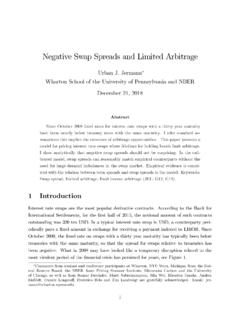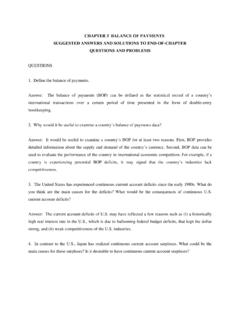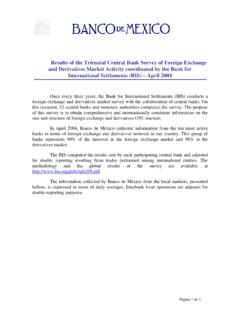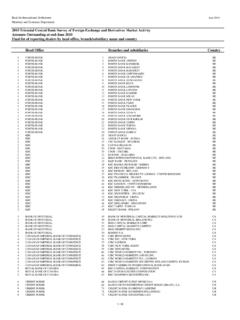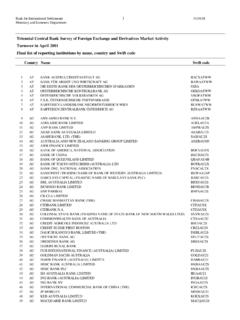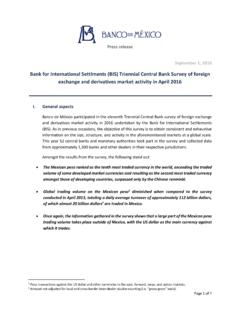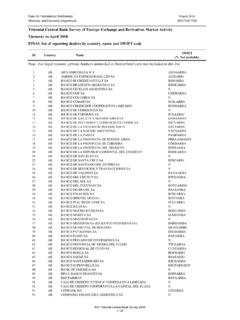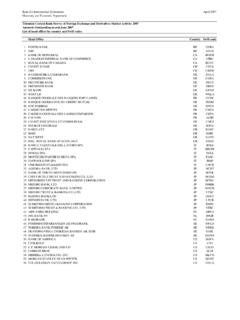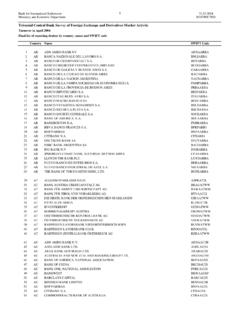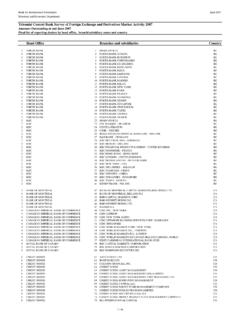Transcription of Central bank survey of foreign exchange and derivatives ...
1 Centralbahnplatz 2 CH-4002 Basel Switzerland Tel: (+41 61) 280 8080 Fax: (+41 61) 280 9100 releasePress enquiries: (+41 61) 280 no: 31/2001E09 October 2001 Central bank survey of foreign exchangeand derivatives market activity in April 2001:preliminary global dataIn April this year, 48 Central banks and monetary authorities participated in the TriennialCentral bank survey of foreign exchange and derivatives Market Activity. They collecteddata on turnover in traditional foreign exchange markets spot, outright forwards andforeign exchange swaps and in over-the-counter (OTC) currency and interest Today many participating Central banks and monetary authorities arepublishing their national survey results and the BIS is releasing preliminary global statisticsfrom the The BIS plans to publish the final global results on foreign exchangemarket turnover and the final statistics on OTC derivatives market turnover and amountsoutstanding in early Traditional foreign exchange marketsForeign exchange market activity declined markedly between 1998 and 2001.
2 This is insharp contrast to the previous surveys, which had shown substantial growth in tradingvolumes. Average daily turnover in traditional foreign exchange markets was estimated at$1,210 billion in April 2001 compared to $1,490 billion in April 1998, representing a 19%decline (Table 1).3 The introduction of the euro, the growing share of electronic broking inthe spot interbank market and consolidation in the banking industry appear to have beenthe main factors driving this fall in foreign exchange market turnover. 1 Data on amounts outstanding of OTC foreign exchange , interest rate, equity, commodity and creditderivatives were collected at end-June and preliminary results will be published in November National results are adjusted for local inter-dealer double-counting while global results are adjusted for bothlocal and cross-border inter-dealer double-counting and for estimated gaps in The five emerging market countries that in 2001 participated for the first time in the survey captured of total foreign exchange turnover (see Table 5).
3 2/13 The decline was most pronounced in spot markets, where average daily turnover fell from$568 to 387 billion. Trading volumes in foreign exchange swaps4 dropped from $734 to656 billion, or by 11%. By contrast, trading in outright forwards slightly increased to$131 April 2001 figures also reveal some changes in the relative importance of tradingbetween different counterparties. Trading between reporting dealers fell substantially, from$909 to 689 billion (Table 2). In April 2001, it captured 59% of total turnover, down from64% in 1998. This can in part be explained by the growing role of electronic brokers in thespot interbank market. The use of electronic brokers implies that foreign exchange dealersgenerally need to trade less actively among themselves. Trading between banks and non-financial customers also declined markedly, from $241 to 156 billion, while transactionsbetween banks and financial customers rose from $279 to 329 billion.
4 The higher tradingvolumes between banks and other financial institutions seem to have reflected theincreasing role of asset managers. Market commentary suggests that the role of hedgefunds in foreign exchange markets has on balance declined somewhat since the terms of the currency composition of foreign exchange market activity, the main impactof the introduction of the euro appears to have been through the elimination of intra-EMStrading. Thus the euro entered on one side of 38% of all foreign exchange transactions higher than the Deutsche mark s share in 1998 (30%) but lower than that of all euroconstituents taken together in 1998 (53%). The relative importance of other currenciesseems not to have changed substantially since 1998. The dollar s share in foreignexchange markets edged up from 87% in 1998 to 90% in 2001 (Table 3).
5 The yen s shareincreased slightly to 23% in was by far the most traded currency pair in 2001 and captured 30% of globalturnover (Table 4). It was followed by dollar/yen with 20% and dollar/sterling with 11%.Trading in local currencies in emerging markets captured about of foreign exchangeactivity in 2001, compared with in data for 2001 reveal an overall decline in the number of reporting banks: 2,772in 48 countries compared to 3,087 in 43 countries in 1998. This is consistent with the broadtrend towards consolidation in the banking industry and the consequent reduction in thenumber of trading desks. This trend seems to have been an additional factor contributingto the decrease in foreign exchange market turnover, especially in the interbank geographical distribution of foreign exchange trading appears not to have changedsubstantially over the last three years (Table 5).
6 Turnover fell in most countries, with somenotable exceptions. In Japan, turnover increased mainly because of a surge in cross-border foreign exchange swaps. In Sweden and Canada, a relaxation of restrictions oninstitutional investors boosted foreign exchange market activity. In Australia, activity roseas a number of global players have centred their Asian time zone foreign exchangebusiness in Australia. Market commentary pointed to a tendency among commercial banksin some continental European countries to move foreign exchange business to London,while in some other countries banks tended to concentrate their business in their homecountry. On balance, these two trends appeared to have offset each other, as the UnitedKingdom s share in total trading was little changed over 1998. 4 foreign exchange swaps commit two counterparties to the exchange of two cash flows and involve the saleof one currency for another in the spot market with the simultaneous repurchase of the first currency in theforward market.
7 By contrast, currency swaps (or cross-currency swaps), which are discussed in the nextsection on OTC derivatives markets, commit two counterparties to several cash flows, which in most casesinvolve an initial exchange of principal and a final re- exchange of principal upon maturity of the contract, andin all cases several streams of interest OTC derivatives marketsIn the OTC derivatives market, average daily turnover in April 2001 amounted to$575 billion, exceeding that in April 1998 by 53% (see Table 6).5 The survey showed acontrast between interest rate and foreign exchange contracts, with the former continuingto grow at a rapid pace (by 85%, to $489 billion) and the latter contracting (by 31%, to $67billion). This divergent path led to a further increase in the relative share of interest rateproducts in overall OTC derivatives activity, to 85% of total turnover compared with 71% inthe previous survey .
8 Data from derivatives exchanges had shown a similar, if lesspronounced pattern, with an expansion of interest rate products and a contraction ofcurrency instruments (see the memorandum items at the bottom of Table 6).6 Expansion in the interest rate segment was driven by the buoyancy of interest rate swaps,with turnover rising by 114%, to $331 billion (see Table 6). Business in dollar-denominatedswaps grew even faster than in the previous survey (by 178%, to $100 billion; seeTable 7), reflecting a deepening of the market possibly driven by a shift in hedging andtrading practices. Net repayments of US government debt have reduced the liquidity oflong-term US government bonds, encouraging market participants to switch to moreeffective hedging and trading instruments, such as interest rate swaps. The higher turnoverof dollar-denominated swaps thus reflects the increased importance of such instruments astrading and pricing in euro-denominated interest rate swaps also expanded rapidly (by 104%, to $173billion).
9 7 The consolidation of activity resulting from the introduction of the euro in January1999 resulted in a temporary decline in business in European interest rate derivatives butthis was quickly offset by the creation of a large and liquid market in euro-denominatedswaps. With European government bond markets remaining heterogeneous, the euro-denominated swap curve has in effect become a new benchmark for European fixedincome markets. By contrast, trading in yen-denominated interest rate swaps expandedmuch more slowly (by 14%, to $16 billion), with activity remaining below that recorded in1995. The low volume of business may have reflected a fairly widespread view at the timeof the survey that Japanese interest rates would evolve in a narrow range for theforeseeable in FRAs witnessed a fairly strong and broad-based expansion (by 74%, to$129 billion; see Table 7), following slower growth in the previous reporting period.
10 Bycontrast, activity in interest rate options, a much smaller segment of the OTC interest ratemarket, contracted by 19%, to $29 billion, with much of the decline occurring in the in currency options, by far the largest group of non-traditional foreign exchangeproducts, dropped substantially (by 31%, to $60 billion; see Table 8). Much of the declinewas concentrated in the dollar/yen pair (-48%). Options involving the dollar and euro areacurrencies declined less sharply (-26%). Currency swaps, a relatively small segment of theOTC derivatives market, also contracted (by 30%, to $7 billion; see Table 8).Overall, business within the group of reporting dealers grew faster (by 74%, to $354 billion;see Table 9) than transactions with non-reporting financial institutions (by 46%, to$159 billion), while transactions with non-financial customers declined (by 16%, to $42billion).
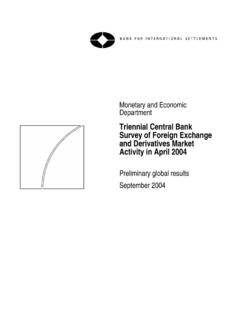


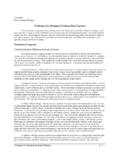
![Dif In Dif Slides.ppt [Repaired] - Wharton Finance](/cache/preview/e/2/9/5/4/6/1/8/thumb-e29546186543c246a2365bc5cbc8c9a4.jpg)
